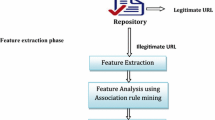Abstract
In the current era of technological advancement, the access to the internet has predominantly increased due to plethoric hand held devices. All day–day activities which require time and energy are being been done effortlessly in the blink of an eye. This extreme sophistication rendered to the mobile Wi-Fi users prorogues them to do all pecuniary transaction through mobile phones. A Wi-Fi hotspot which connects such hand held devices has become a temporary repository of sensitive information, thereby giving an opportunity for hackers to accrue monetary gain. Therefore information security policies addressing Wi-Fi hotspots (Wi-Fi phishing attack) has become the need of the hour. The possible ways to attack the security of Wi-Fi hotspots and counter-attack mechanisms has been addressed in this paper. In this paper a live Wi-Fi Phishing attack has been demonstrated and a novel approach based on association rule mining to circumvent the same has been discussed in this paper.

















Similar content being viewed by others
References
http://krebsonsecurity.com/2015/08/fbi-1-2b-lost-to-business-email-scams/.
https://blog.cloudmark.com/2016/01/13/survey-spear-phishing-a-top-security-concern-to-enterprises/.
http://seattlecentral.edu/faculty/ymoh/mic265/WiFi/WiFi.html.
computer.howstuffworks.com/wireless-network.htm.
http://www.linksys.com/us/support-article?articleNum=134478.
Gopinath, K. N., & Chaskar, H. A quick reference to Rogue AP security threat, Rogue AP detection and mitigation. AirTight Networks www.AirTightNetworks.com.
https://technet.microsoft.com/en-in/library/cc787921(v=ws.10).aspx.
Aydin, M., &Baykal, N. (2015). Feature extraction and classification phishing websites based on URL. In 2015 IEEE Conference on Communications and Network Security (CNS), pp. 769–770.
Khonji, M., Jones, A., & Iraqi, Y. (2011). A novel Phishing classification based on URL features. In 2011 IEEE GCC Conference and Exhibition (GCC), pp. 221–224.
Mallik, S., & Mukhopadhyay, A. RANWAR: Rank-based weighted association rule mining from gene expression and methylation data. IEEE Transactions on Nano Bioscience.
Soltani, A., & Akbarzadeh-T, M.-R. Confabulation-inspired association rule mining for rare and frequent itemsets. IEEE Transactions on Neural Networks and Learning Systems.
Phish tank. http://www.phishtank.com/. Accessed on October 26, 2009.
Kesler, B., Drinan, H., & Fontaine, N. (2006). News briefs. IEEE Security and Privacy, 4(2), 8–13.
Garera, S., Provos, N., Chew, M., & Rubin, A. D. (2007). A framework for detection and measurement of phishing attacks. In WORM ‘07: Proceedings of the 2007 ACM workshop on Recurring malcode, pp. 1–8, New York, NY, USA, 2007. ACM.
Pan, Y., & Ding, X. (2006). Anomaly based web phishing page detection. In ACSAC ‘06: Proceedings of the 22nd Annual Computer Security-Applications Conference, pp. 381–392, Washington, DC, USA, 2006. IEEE Computer Society.
Dunlop, M., Groat, S., & Shelly, D. (2010). GoldPhish: Using images for content-based phishing analysis. In The fifth international conference on internet monitoring and protection, Virginia Polytechnic Institute and State University, Blacksburg, VA 24060, USA, 2010.
Kontaxis, G., Polakis, I., Ioannidis, S., & Markatos, E. P. Detecting social network profile cloning. Foundation for Research and Technology Hellas—Institute of Computer Science.
Khonji, M., Jones, A., & Iraqi, Y. (2011). A novel phishing classification based on url features. In 2011 IEEE GCC conference and exhibition (GCC), Dubai, United Arab Emirates, 2011.
Sheng, S., Wardman, B., Warner, G., Cranor, L. F., Hang, J., & Zhang, C. (2009). An empirical analysis of phishing blacklists. http://ceas.cc/2009/papers/ceas2009-paper-32.pdf. Accessed July 2010.
Aburrous, M., Hossain, M. A., Dahal, K., & Thatah, F. (2010a). Predicting phishing websites using classification mining techniques with experimental case studies. In Seventh International Conference on Information Technology, IEEE Conf, LasVegas, Nevada, USA, (pp. 176–181).
Aburrous, M., Hossain, M. A., Dahal, K., & Thatah, F. (2010b). Intelligent phishing detection system for e-banking using fuzzy data mining. Expert systems with applications, 37(12), 7913–7921
Shahriar, H., Zulkernine, M. (2010). Trustworthiness testing of phishing websites: A behavior model-based approach. In Future Generation Computer Systems. School of Computing, Queen‘s University, Kingston, Canada.
Barraclough, P. A., Hossain, M. A., Tahir, M. A., Sexton, G., & Aslam, N. (2013). Intelligent phishing detection and protection scheme for online transactions. Expert Systems with Applications, 40, 4697–4706.
http://truehackkers.blogspot.in/2014/11/hack-like-pro-how-to-spoof-dns-on-lan.html.
Agrawal, R., Imieliński, T., & Swami, A. (1993). Mining association rules between sets of items in large databases. In SIGMOD ‘93 Proceedings of the 1993 ACM SIGMOD international conference on Management of data.
Abdelhamid, N., Ayesh, A., & Thabtah, F. (2013) Associative classification mining for website phishing classification. In Proceedings of the ICAI ‘2013, pp. 687–695, USA.
Kuoa, R. J., Chao, C. M., & Chiuc, Y. T. (2011). Application of particle swarm optimization to association rule mining. Applied Soft Computing, 11, 326–336.
Wur, S.-Y., & Leu, Y. (1999). An effective boolean algorithm for mining association rules in large databases. In Proceeding DASFAA ‘99 Proceedings of the sixth international conference on database systems for advanced applications, pp. 179–186.
Kung, S. H. (2002). Applying genetic algorithm and weight item to association rule. Master Thesis, Department of Industrial Engineering and Management, Yuan Ze University, Taiwan.
Author information
Authors and Affiliations
Corresponding author
Rights and permissions
About this article
Cite this article
Aravindhan, R., Shanmugalakshmi, R. & Ramya, K. Circumvention of Nascent and Potential Wi-Fi Phishing Threat Using Association Rule Mining. Wireless Pers Commun 94, 2331–2361 (2017). https://doi.org/10.1007/s11277-016-3451-1
Published:
Issue Date:
DOI: https://doi.org/10.1007/s11277-016-3451-1




